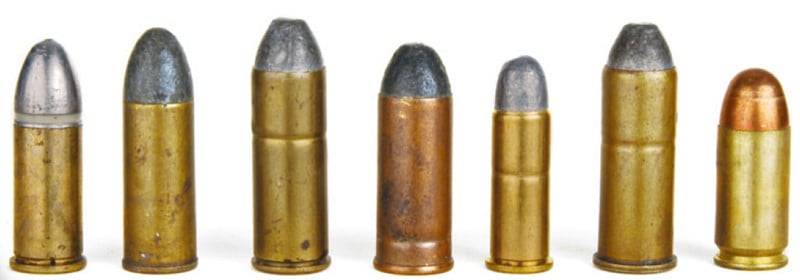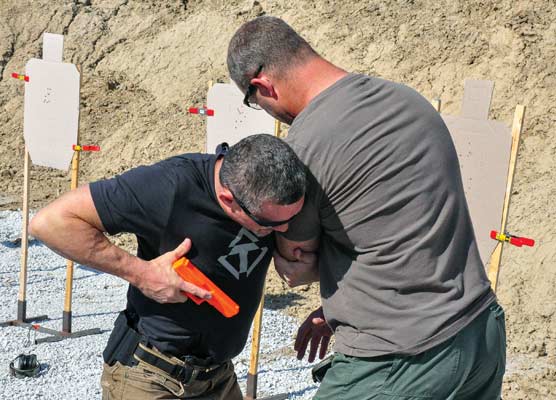The U.S. Cavalrys Other Handguns
The Colt SAA revolver only served officially for the U.S. Cavalry between 1873 and 1892, which begs the question of what other handguns served American horse soldiers before and after those years?
Mostly they were made by Colt and mostly revolvers. Although during the Civil War the federal government armed their horse soldiers with just about any revolver that could be purchased in quantity its “standard issue” was Colt’s Model 1860 Army. That was a cap and ball revolver of .44 caliber, and it was on active duty until a metallic cartridge-firing revolver was adopted circa 1870.
That first U.S. revolver taking fixed ammunition happened to be S&W’s Model No. 3, chambered for the cartridge eventually named .44 American. Its tenure was short, as was the Colt Richard’s conversion in .44 Colt caliber, the adoption of which shortly followed the S&W. Actually the government only bought 1,000 of the Smith & Wessons and 1,200 of the Colts during that time.
1911 Horse Soldiers
In 1909 the army decided to return to a .45 caliber revolver, knowing full well it was a stopgap measure because they already were set on soon adopting an autoloader. The Model 1909 was simply the Colt New Service revolver chambered for .45 Colt again. However, to make sure extraction was positive the government-loaded .45s had a wider rim by about .025″ than civilian issue .45 Colts.
When the U.S. Cavalry adopted the Colt Model 1911 they had the sidearm that stayed with them until horses were retired from active duty during World War II. That’s probably a fact somewhat hard for most Model 1911 lovers to accept — it was actually designed with horse soldiers in mind.
Here’s something interesting. Except for the .38 Colt, all of the U.S. Cavalry’s handgun cartridges were similar in power. Mostly they fired 225-to 250-grain bullets at 725 to 750 fps. There’s a fable the big .45 Colt used a 250-grain bullet over 40 grains of black powder for 900 fps. Not in government service, it didn’t. Loads for the U.S. Army contained only 30 grains of powder with those 250-grain bullets, and would have been lucky to hit 750 fps.
A box of Model 1909 military .45 Colt loads I own says velocity with 250-grain bullets was 725 fps with a plus/minus factor of 25 fps. Nominal ballistics for the .45 ACP called for a 230-grain bullet at 830 fps, but the military surplus ammo I’ve personally fired chronographed more in the 750 to 770 fps range. So there you go.
Tough Moros
It’s a little known fact the U.S. Cavalry also toyed with a single shot, cartridge-firing handgun in the early 1870s. This was the .50 caliber Remington Model 1871 using their rolling block form of action. It seems extremely odd the army issued such a handgun when revolvers had been common for decades, but then again governments have been known to do stranger things.
The Colt SAA was adopted in 1873, but S&W didn’t give up easily. They were actually able to get a remodeled No. 3 adopted as “substitute standard” by the army in the mid-1870s. In fact their shorter .45 caliber cartridge was adopted as standard issue for both Colt and S&W revolvers as early as August 1874. Since an army officer named Schofield had redesigned this S&W Model No. 3, that informal moniker has stuck. By 1880, the army tired of having two types of sixgun in service and sold the S&Ws as surplus. The S&W “Schofield” had a 7″-barrel and walnut grips.
For a dozen years the Colt SAA reigned supreme, but in 1892 the army adopted its first standard-issue DA with swing out cylinder. The Colt DA .38 in its basic form with 6″-barrel and walnut grips was standard issue for nearly as long as the big Colt .45. Its puny .38 Colt cartridge used a 150-grain bullet moving at barely 750 fps, and this revolver was official issue during the Spanish-American War and the Philippine Insurrection. As such, it no doubt saw more action than the famous Colt SAA .45 did during the Indian Wars.
After all it was the .38 Colt DA, which spawned all the stories of U.S. troopers being killed after emptying their revolvers into attacking Moro warriors during the Philippine Insurrection. That led the U.S. military into going back to a large bore handgun; at least until the mid-1980s.

Get More Revolver Content Every Week!
Sign up for the Wheelgun Wednesday newsletter here:







